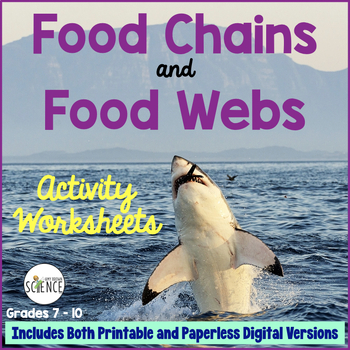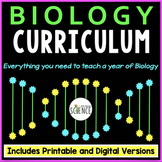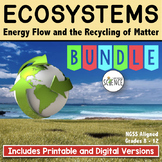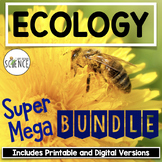Food Chains and Food Webs Activity Worksheets
- Zip
- Google Apps™

What educators are saying
Also included in
- This NO PREP, PRINTABLE, EDITABLE, AND DIGITAL Biology Curriculum contains everything you need for an entire year of Biology! For less than $3 a day, you can save your time, energy, and sanity. Each of the 20 Complete Units includes a teaching PowerPoint presentation, notes, labs, homework assignmenPrice $525.00Original Price $988.18Save $463.18
- This "Ecosystems Complete Unit Bundle" covers the flow of energy through ecosystems, the recycling of matter, food chains and food webs, energy pyramids, biogeochemical cycles, and more. See complete list of topics covered below.This unit bundle includes everything you need to teach a unit on ecosysPrice $39.99Original Price $52.72Save $12.73
- All of my ecology and environmental science resources (6 ecology unit bundles) are included in this one Super-Mega-Bundle! This mega-bundle includes all of the PowerPoints, notes, labs, task cards, homework assignments, review games, quizzes, activities, and unit tests that you need to teach a compPrice $178.00Original Price $252.64Save $74.64
Description
In this 9-page activity, students will explore food chains, food webs, energy pyramids, trophic levels, energy flow, producers, consumers, decomposers, autotrophs, heterotrophs, and all the vocabulary terms associated with these concepts. I have included this activity in a traditional printable format as well as a paperless digital format for use in Google Drive, Google Classroom, and/or Microsoft OneDrive.
This resource includes:
- Editable and Printable 9-Page Student Handout (50 Questions)
- Colorful diagrams and illustrations.
- 3-Pages of pictures to use in cut and paste activities
- Critical thinking and problem solving activities
- 9-Page teacher guide with tips, suggestions, and complete answer key.
- Paperless Digital Version with drag and drop images for use in Google Drive, Google Classroom, and/or Microsoft OneDrive.
- Teacher User Guide for Google Apps
Perfect for students in grades 8 - 10.
What concepts are covered?
- Producers and consumers: Students will define terms and provide examples of producers, herbivores, carnivores, omnivores and decomposers.
- Students will complete a "cut and paste" activity where they sort 15 organisms into the following categories: producers, herbivores, carnivores, omnivores and decomposers.
- Food Chains: Given a diagram of a food chain, students will answer a series of critical thinking and problem solving questions. Students will identify the producer, the primary consumer, the secondary consumer, the tertiary consumer and the quaternary consumer.
- The importance of decomposers in the food chain.
- Students will sort 24 organisms into 6 different food chains: Ocean, woodland, salt marsh, arctic, desert, and freshwater pond. Students must place the organism in the correct food chain and in the correct order.
- Food Webs: Students will use a diagram of a food web to answer a series of questions.
- The difference between food chains and food webs.
- Detritivores and decomposers.
- Autotrophs and heterotrophs.
- Students will design a complex food web by cutting and pasting 15 different organisms into a freshwater pond ecosystem. The student will connect the organisms by drawing arrows between them.
- Energy Flow Through the Ecosystem: Students will read a short passage and answer higher level thinking questions.
- Students will use a diagram of an energy pyramid and answer a series of questions.
- Trophic levels, energy transfer, energy loss.
- Students will calculate how many Calories of energy are passed to each trophic level.
- Students will draw and design a food pyramid of their choice.
This is a NO PREP activity. Everything you need is included. You only have to duplicate the pages and pass them out to your students.
Related Products Include:
Outdoor Lab Activity: Exploring an Ecosystem
Introduction to Ecology PowerPoint with Notes for Teacher and Student
Population Ecology PowerPoint with Notes for Teacher and Student
Introduction to Ecology Task Cards
Community Ecology Powerpoint and Notes
Ecosystems and the Biosphere Part 2: Biomes of the World PowerPoint and Notes
Human Impact PowerPoint and Notes
FREE Set of Six Ecology Crossword Puzzles
Lichens: Informational Text, Critical Reading and Lab Activity
FREE! Backyard Ecology: An Ecological Assessment of Your Back Yard
Community Ecology Homework and Study Guide
Lab: How is the Germination of Seeds Affected by Abiotic Factors?
Habitat and Niche Practice Problem Worksheet
Ecology Interactive Notebook Pages and Warm Ups
Awards for the Most Amazing Plants and Animals on Earth
Predator/Prey Relationships Graphing Activity
For updates about sales and new products, please follow my store:








